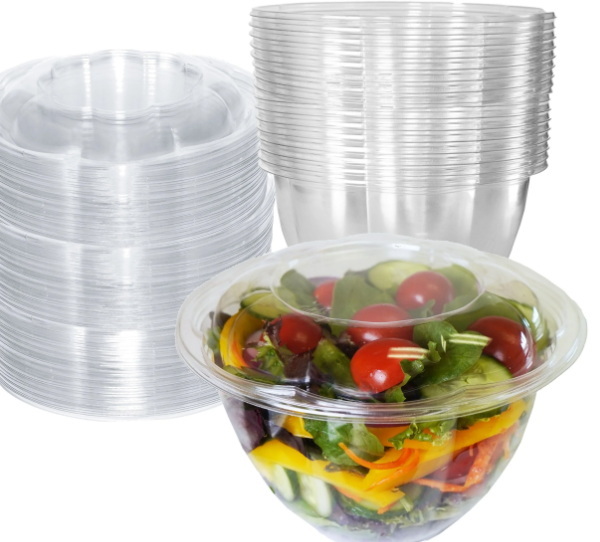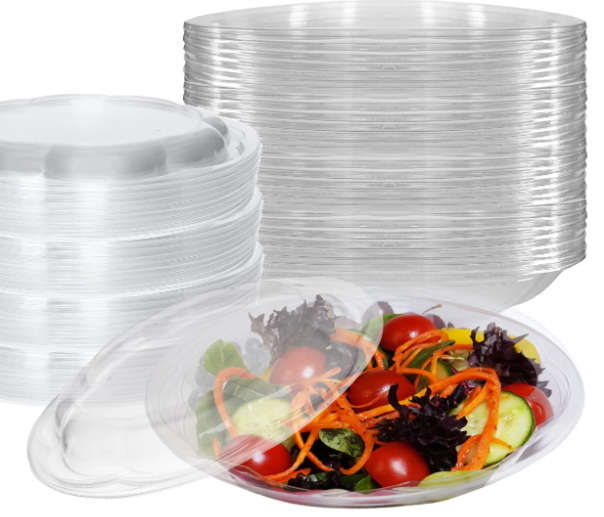
Content Menu
● Introduction to Disposable Salad Bowls
>> Materials for Disposable Salad Bowls
● Factors to Consider When Choosing Disposable Salad Bowl Size
>> Portion Sizes
>> Food Type
>> Sustainability
>> Brand Promotion
● Popular Disposable Salad Bowl Sizes
>> Compostable PLA Bowls
● Tips for Selecting the Right Disposable Salad Bowl Size
● Customization and Branding
● Storage and Logistics
● Environmental Impact
● Conclusion
● FAQs
>> 1. What are the common sizes for disposable salad bowls?
>> 2. How do I choose the right material for my disposable salad bowls?
>> 3. What factors should I consider when selecting the shape of disposable salad bowls?
>> 4. Are all disposable salad bowls microwave safe?
>> 5. How can I ensure my disposable salad bowls are sustainable?
● Citations:
Choosing the right disposable salad bowl size is crucial for both businesses and individuals looking to serve salads efficiently and attractively. The size of the bowl can significantly impact the presentation, convenience, and overall dining experience. In this article, we will explore the factors to consider when selecting the perfect disposable salad bowl size, including material options, portion sizes, and sustainability considerations.

Introduction to Disposable Salad Bowls
Disposable salad bowls are versatile and convenient, available in various materials such as plastic, paper, and biodegradable options. These bowls are ideal for picnics, office lunches, and catering events where quick cleanup is essential. The choice of material and size depends on the type of salad, serving style, and environmental considerations.
Materials for Disposable Salad Bowls
1. Plastic Salad Bowls: Durable and often come with lids, which help keep salads fresh and secure. Look for BPA-free options to ensure food safety. Plastic bowls are lightweight, affordable, and suitable for both hot and cold foods[5].
2. Paper Bowls: Lightweight and eco-friendly, suitable for dry or semi-dry foods. They are a popular choice for businesses aiming to reduce their environmental footprint. Paper bowls are available in natural Kraft or white paper options, which can be customized with designs or branding[7].
3. Biodegradable Bowls: Made from materials like cornstarch or sugarcane, these bowls are designed to break down naturally, appealing to eco-conscious consumers. Biodegradable bowls are compostable and certified by organizations such as the Compostable Materials Institute (CMI)[2].
Factors to Consider When Choosing Disposable Salad Bowl Size
Portion Sizes
The size of the bowl should match the portion size of your salads. Common sizes include:
- Small Bowls (2–5 oz): Ideal for appetizers or small servings.
- Medium Bowls (10–16 oz): Suitable for side dishes or single servings.
- Large Bowls (20 oz and above): Perfect for family-style meals or large salads.
For appetizer salads or side dishes, smaller bowls in the range of 8 to 12 ounces may be suitable, while main course salads require larger bowls ranging from 32 to 64 ounces or more[4].
Food Type
Different foods require different bowl shapes and sizes:
- Salads and Cold Dishes: Opt for wide bowls (750-1000 ml) for better plating. This size is ideal for salads like Caesar or Greek salads[6].
- Pasta and Rice Dishes: Compact shapes (500-750 ml) are ideal for easy storage and serving.
- Soups and Stews: Round bowls (500-750 ml) help retain heat and prevent spills.
Sustainability
Eco-friendly options like paper and biodegradable bowls are gaining popularity due to their environmental benefits. These materials reduce waste and support sustainable practices, making them appealing to environmentally conscious consumers[3].
Brand Promotion
The design and size of the bowl can enhance your brand's aesthetic and appeal to customers. Customizable bowls allow for branding and design options that match your event theme or brand identity[3].

Popular Disposable Salad Bowl Sizes
Here are some common sizes and their recommended uses:
| Bowl Size (ml) | Diameter (mm) | Height (mm) | Base Diameter (mm) | Recommended Food Portions or Types |
| 500ml | 150 | 45 | 128 | Soups, ice cream, small salads |
| 750ml | 150 | 60 | 128 | Medium salads, pasta dishes |
| 1000ml | 150 | 75 | 128 | Large salads, stews, family-sized desserts |
| 1100ml | 165 | 70 | 144 | Hearty servings of noodles, rice dishes |
| 1300ml | 185 | 65 | 160 | Bulk servings, party snacks, large salads |
Compostable PLA Bowls
Compostable PLA bowls are another eco-friendly option, available in sizes such as 16, 24, 32, and 48 oz. These bowls are made from plant-based bioplastics and are certified compostable, making them a sustainable choice for businesses[2].
Tips for Selecting the Right Disposable Salad Bowl Size
1. Analyze Your Menu: Match bowl sizes with your menu items to ensure the right portion sizes and presentation.
2. Consider Customer Feedback: Adjust bowl sizes based on customer preferences to reduce waste and improve satisfaction.
3. Bulk Purchase: Buy bowls in bulk to reduce costs and negotiate better rates with suppliers.
4. Standardize When Possible: Use standard sizes to streamline inventory and logistics.
5. Sustainability Considerations: Opt for eco-friendly materials to reduce environmental impact.
Customization and Branding
Disposable salad bowls can be customized with designs or branding to enhance your brand's visibility. This is particularly useful for events or promotions where consistent branding is important. Custom designs can include logos, colors, or themes that match your event or brand identity[3].
Storage and Logistics
When selecting disposable salad bowls, consider storage and logistics. Compact shapes and stackable designs can optimize storage space and make transportation easier. This is especially important for large events or businesses with limited storage capacity[6].
Environmental Impact
The environmental impact of disposable salad bowls is a significant concern. Traditional plastic bowls contribute to plastic waste, while eco-friendly options like paper and biodegradable bowls offer a more sustainable alternative. Compostable PLA bowls also provide a biodegradable solution, composting in commercial facilities within a few months[2].
Conclusion
Choosing the right disposable salad bowl size is essential for enhancing the dining experience, reducing waste, and promoting sustainability. By considering factors such as portion sizes, food types, and environmental impact, businesses and individuals can select bowls that meet their needs while appealing to eco-conscious consumers.

FAQs
1. What are the common sizes for disposable salad bowls?
Disposable salad bowls come in a variety of sizes, including small (2–5 oz), medium (10–16 oz), and large (20 oz and above). The choice depends on the portion size and type of salad being served.
2. How do I choose the right material for my disposable salad bowls?
The choice of material depends on the type of food, serving style, and environmental considerations. Plastic bowls are durable and suitable for wet foods, while paper and biodegradable bowls are eco-friendly options for dry or semi-dry foods.
3. What factors should I consider when selecting the shape of disposable salad bowls?
The shape of the bowl should match the type of food. Round bowls are ideal for soups and stews, while wide bowls are better for salads and cold dishes. Square or rectangular bowls are space-efficient and suitable for pasta or rice dishes.
4. Are all disposable salad bowls microwave safe?
Not all disposable salad bowls are microwave safe. Check the manufacturer's guidelines, especially for paper and biodegradable bowls, as they may not withstand high temperatures.
5. How can I ensure my disposable salad bowls are sustainable?
Opt for eco-friendly materials like paper or biodegradable bowls. These options reduce waste and support sustainable practices. Also, consider compostable or recyclable bowls to minimize environmental impact.
Citations:
[1] https://gmz.ltd/how-to-choose-the-right-paper-bowl-sizes-a-quick-guide/
[2] https://www.goodstartpackaging.com/24-oz-round-pla-salad-bowls-SB-CS-24/
[3] https://packagingbox.pk/product/salad-bowls/
[4] https://customcupfactory.com/blogs/news/what-size-should-restaurants-have-for-salad-bowls-with-lids
[5] https://smartyhadaparty.com/blogs/home/the-plastic-bowls-kingdom-the-ultimate-solution-for-your-salad-needs
[6] https://droppe.com/blog/article/how-to-choose-the-right-size-and-shape-of-takeaway-bowls-for-your-menu/
[7] https://kare-pack.com/salata-kasesi-32-oz-1000cc
[8] https://this-element.com/collections/salad-bowls
[9] https://www.yanxiyan.com/paper-bowl/
[10] https://www.enviropack.org.uk/cold-food-containers/paperboard-salad-containers
[11] https://www.envirochoice.com.au/containers/salad-bowls
[12] https://www.sweetflavorfl.com/blog/everything-you-need-to-know-about-disposable-salad-bowls-n14
[13] https://www.webstaurantstore.com/guide/651/disposable-take-out-containers-guide.html
[14] https://www.justsalad.com/reusablebowl
[15] https://diyecobox.com/perfect-guide-to-disposable-plate-sizes/
[16] https://www.hydepackage.com/info-detail/a-few-tips-for-choosing-a-salad-paper-bowl
[17] https://academy.monouso-direct.com/types-of-bowls/
[18] https://www.ecosoulhome.com/blogs/sustainable-living/5-tips-for-choosing-the-best-disposable-bowls-for-hot-soup
[19] https://www.pinnaclepacks.com/blog/best-disposable-bowls-for-hot-food-and-soup/
[20] https://www.solia-usa.com/disposable-salad-bowl-with-lid-usa/

















